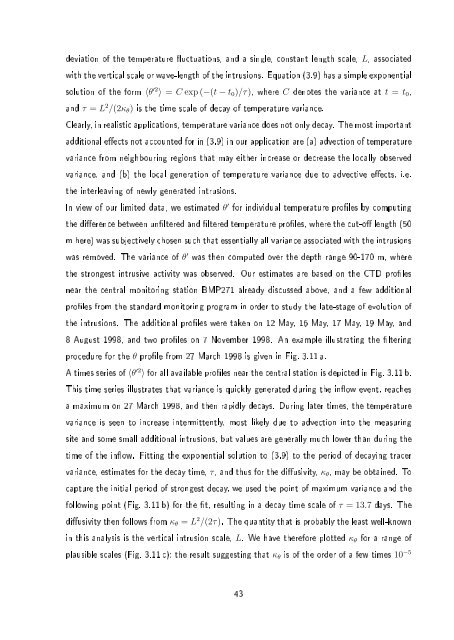Baltic Sea
Baltic Sea
Baltic Sea
You also want an ePaper? Increase the reach of your titles
YUMPU automatically turns print PDFs into web optimized ePapers that Google loves.
deviation of the temperature uctuations, and a single, constant length scale, L, associated<br />
with the vertical scale or wave-length of the intrusions. Equation (3.9) has a simple exponential<br />
solution of the form 〈θ ′2 〉 = C exp (−(t − t 0 )/τ), where C denotes the variance at t = t 0 ,<br />
and τ = L 2 /(2κ θ ) is the time scale of decay of temperature variance.<br />
Clearly, in realistic applications, temperature variance does not only decay. The most important<br />
additional eects not accounted for in (3.9) in our application are (a) advection of temperature<br />
variance from neighbouring regions that may either increase or decrease the locally observed<br />
variance, and (b) the local generation of temperature variance due to advective eects, i.e.<br />
the interleaving of newly generated intrusions.<br />
In view of our limited data, we estimated θ ′ for individual temperature proles by computing<br />
the dierence between unltered and ltered temperature proles, where the cut-o length (50<br />
m here) was subjectively chosen such that essentially all variance associated with the intrusions<br />
was removed. The variance of θ ′ was then computed over the depth range 90-170 m, where<br />
the strongest intrusive activity was observed. Our estimates are based on the CTD proles<br />
near the central monitoring station BMP271 already discussed above, and a few additional<br />
proles from the standard monitoring program in order to study the late-stage of evolution of<br />
the intrusions. The additional proles were taken on 12 May, 16 May, 17 May, 19 May, and<br />
8 August 1998, and two proles on 7 November 1998. An example illustrating the ltering<br />
procedure for the θ prole from 27 March 1998 is given in Fig. 3.11 a.<br />
A times series of 〈θ ′2 〉 for all available proles near the central station is depicted in Fig. 3.11 b.<br />
This time series illustrates that variance is quickly generated during the inow event, reaches<br />
a maximum on 27 March 1998, and then rapidly decays. During later times, the temperature<br />
variance is seen to increase intermittently, most likely due to advection into the measuring<br />
site and some small additional intrusions, but values are generally much lower than during the<br />
time of the inow. Fitting the exponential solution to (3.9) to the period of decaying tracer<br />
variance, estimates for the decay time, τ, and thus for the diusivity, κ θ , may be obtained. To<br />
capture the initial period of strongest decay, we used the point of maximum variance and the<br />
following point (Fig. 3.11 b) for the t, resulting in a decay time scale of τ = 13.7 days. The<br />
diusivity then follows from κ θ = L 2 /(2τ). The quantity that is probably the least well-known<br />
in this analysis is the vertical intrusion scale, L. We have therefore plotted κ θ for a range of<br />
plausible scales (Fig. 3.11 c); the result suggesting that κ θ is of the order of a few times 10 −5<br />
43



